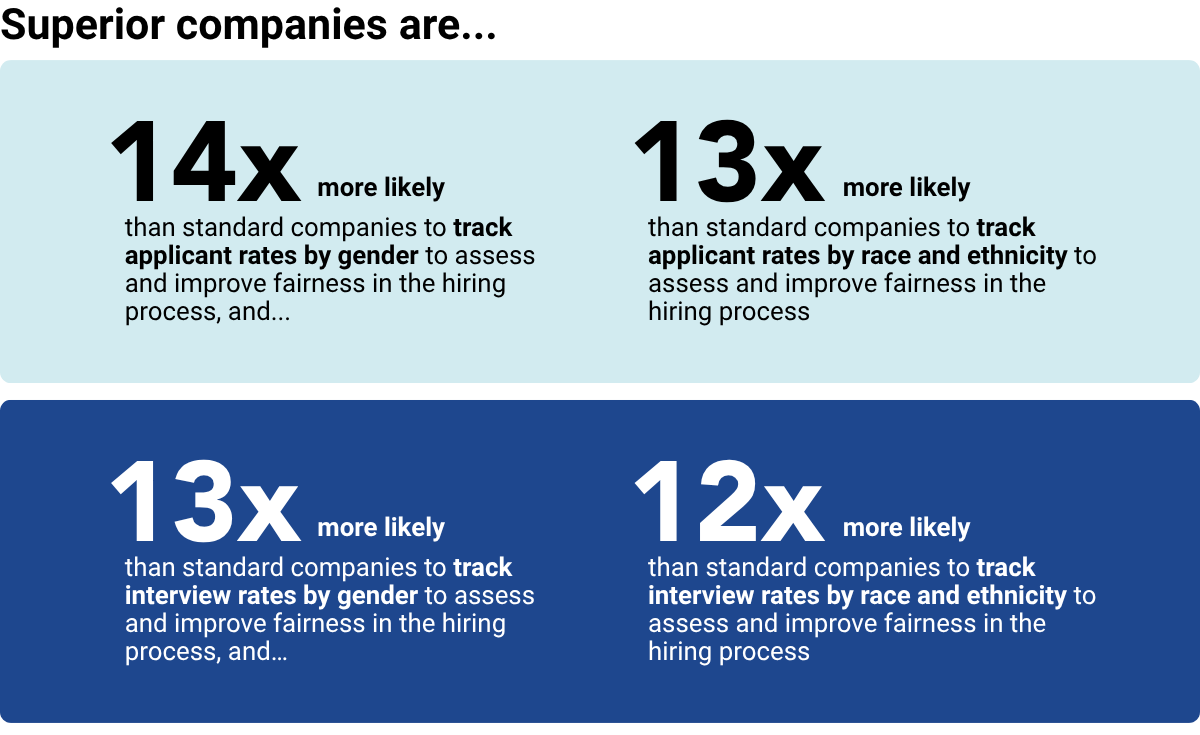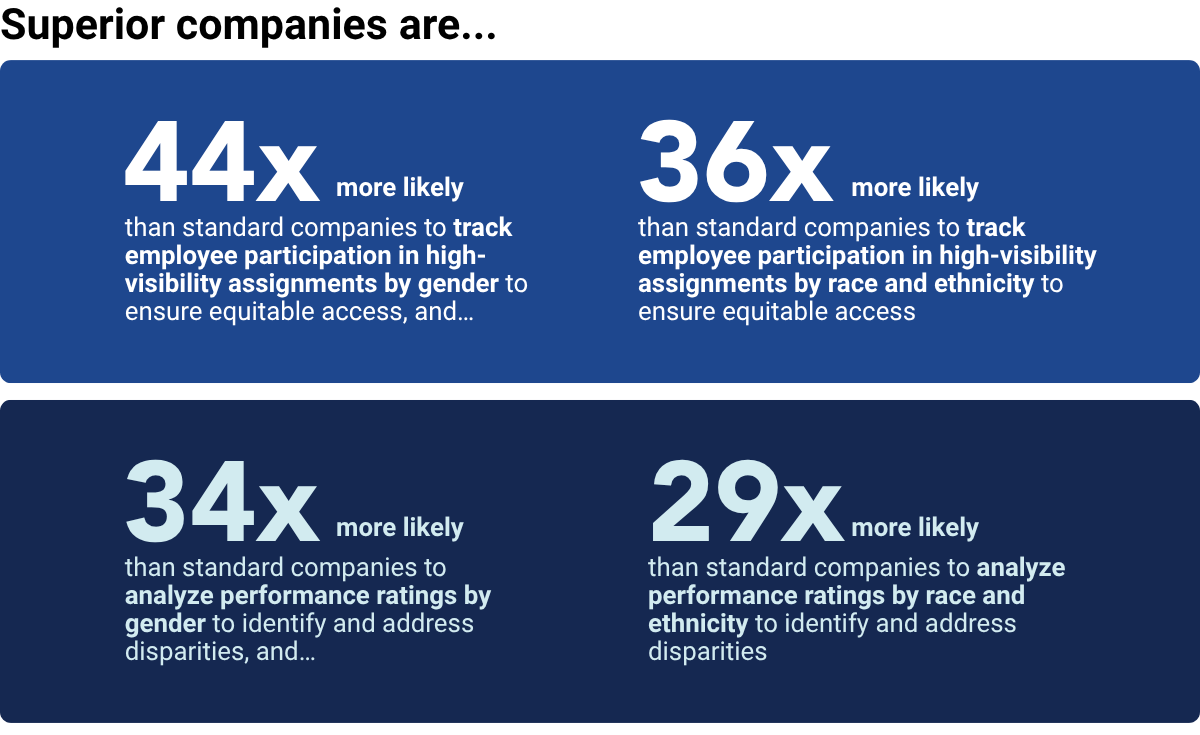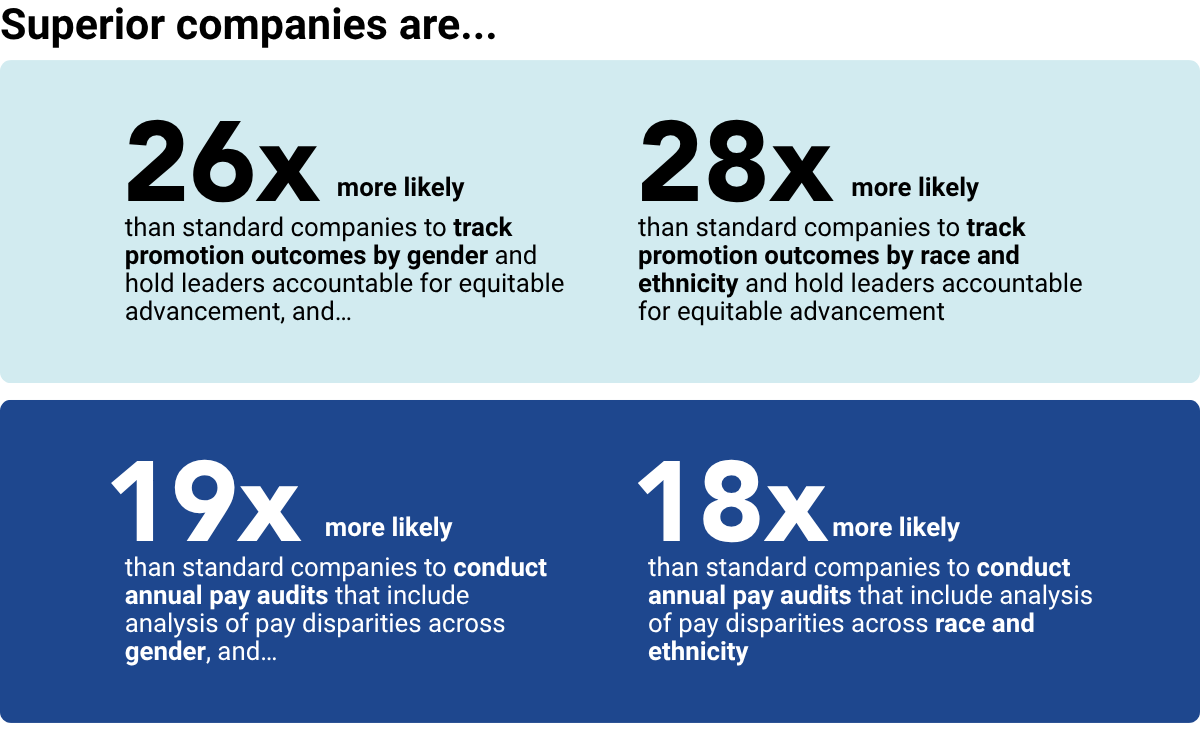The powerful business impact of HR measurement practices
24 min read
| Published on
Executive summary
What if we told you that there is something that could triple your ability to improve business performance, customer loyalty, and attraction of diverse talent, and double your likelihood of enhanced employee engagement and inclusion?
There is.
Now what if we told you that the “something” is leveraging HR measurement practices to detect and address gender, racial, and ethnic inequities in the workplace?
This was the surprising and powerful finding uncovered by our survey of more than 500 HR professionals in Canada, the United Kingdom, and the United States in June and July 2025. Harnessing HR leaders’ collective expertise, we identify what talent practices are currently in place at organizations and uncover what sets high-caliber organizations apart from the rest.
We recognize that many of the HR measurement practices featured in this research — specifically those that aim to address inequities in the workplace — are at the center of cross-regional turbulence, buffeted by fierce headwinds in the United States and regulation-fueled tailwinds in the United Kingdom.1
And that is exactly why you need this data.
Read this report for action-oriented recommendations on whether, why, and how your organization should measure talent gaps as you seek to drive business impact.
How to cite: Shaffer, E., Robotham, K., & Van Bommel, T. (2025). The powerful business impact of HR measurement practices. Catalyst.
The content on this page is for advisory purposes only and should not be construed as legal advice. You can use these guidelines to help inform discussions with your legal counsel.
1. Companies are either “superior” or “standard” based on the quantity and quality of their HR practices
Quantity
We found that we could separate companies into two categories.2 “Superior” companies are highly committed to a wide range of talent management practices, engaging in 93% of the practices we asked about.3 A majority of the organizations (60%) we surveyed fell into this category. But a large minority (40%) of companies are “standard,” engaging in far fewer best practices — only 57% — that comprise an established core of foundational HR actions.
Quality
Superior companies also distinguish themselves by the type of practices they implement.4 They are more likely than standard companies to leverage measurement practices that detect gender, racial, and ethnic inequities in the workplace.5 These organizations are gathering data to understand how talent progresses through the organization at each stage of the employee lifecycle. Critically, they are then using that data to map out a path that leads to equity of opportunity for all employees regardless of gender, race, or ethnicity. Nearly all superior organizations are engaged in these key practices, which we list below, compared to only about half of standard organizations. (See the Appendix for the full list of best practices we investigated.)






Collectively, these measurement practices make up a comprehensive strategy to uncover, track, and address gaps related to gender, race, and ethnicity in the workplace. For example, an organization would be able to uncover whether women from marginalized racial and ethnic groups are accessing proportionately fewer advancement opportunities than others, or if White men experience less belonging.
This approach allows organizations to identify gaps in experiences and outcomes for any employee group. If your company can implement a strategy with these elements, you will gain indispensable insights into employee experiences, pinpoint areas of strength and opportunity that your organization can build on for future progress, and reinforce a true meritocratic system where there is fair access to opportunity for all.
2. HR best practices pay off
The measurement practices listed above aren’t just “nice to have” — they power sought-after business benefits. HR leaders at superior companies are 3x more likely than those from standard organizations to report that their talent practices greatly improved:
- Business performance.6
- Customer loyalty.7
- Ability to attract talent from underrepresented groups.8
- Ability to retain talent from underrepresented groups.9
And, they are 2x more likely to report that their talent practices greatly improved:
When your organization gathers and analyzes data by demographic groups, you can discern nuances that make it possible to tailor strategies and prioritize solutions. Doing so on a regular cadence makes the real impact of actions visible and shows you where adjustments can be made to drive progress toward a more inclusive, equitable — and successful — workplace.
Importantly, the solutions to any disparities uncovered can but do not need to be programs that exclusively target specific groups of employees, which are currently discouraged in the United States.12 Instead, broader actions such as offering inclusive leadership training, developing structured interview protocols, having transparent promotion processes, and communicating organization values lay the foundation for everyone to succeed.
3. More best practices = better business results
As companies add HR best practices to their portfolio, they boost financial performance,13 customer loyalty,14 ability to attract15 and retain16 employees from underrepresented groups, employee engagement,17 and employee experiences of inclusion.18

This means that standard companies must strive to go beyond the core set of best practices that were implemented by nearly all organizations. These are valuable, foundational HR practices such as:
- Including content that communicates a commitment to a diverse and inclusive workplace in an onboarding program.
- Using standardized processes to minimize bias in starting pay offers (e.g., setting uniform starting salaries and pay bands; limiting salary negotiation).
- Conducting regular employee engagement surveys to assess workplace culture.
Progress is accelerated and impact is more likely when your company implements a comprehensive suite of talent management practices that includes the ones mentioned above, as well as mechanisms to measure gaps in experiences and outcomes. For example, assessing the impact of mentorship programs, flexible work policies, inclusive leadership training, and other initiatives is essential for realizing the extensive benefits of a more diverse and inclusive environment. Indeed, organizations that track and analyze pay equity metrics have seen meaningful improvements in employee retention19 and morale,20 corroborating our findings here.
Take action: Roadmap to unlock business opportunity and success
Around the world, companies are charting varied paths to an inclusive and equitable workplace. As our survey results show, many are using HR practices that measure whether everyone has equal opportunity, is evaluated on merit, and can thrive free from bias.
If you are an HR or business leader, you want to make strategic, data-backed choices about talent practices. Your decisions about how to move forward will vary based on region, regulatory pressures, and risk tolerance. Are you cruising ahead, buoyed by strong tailwinds? Are you proceeding cautiously, considering all your options? Or are you pausing certain practices to assess headwinds? No matter your situation, you can use the insights and recommendations listed below to guide your strategy.
Cruising ahead
One reason organizations reach superior status is that they are always striving to do better. If your company operates in a supportive regulatory climate and/or is committed to maintaining a robust measurement strategy, consider the following actions to continually push the boundaries of what “best” looks like.
- Ensure: Leaders should detail the return on investment from engaging in measurement practices and link them to organizational values when speaking to internal audiences.
- Hold your company to the gold standard of accountability for social and environmental impacts by adhering to the EU’s Corporate Sustainability Reporting Directive (CSRD).21 Even if your company is not required to comply with these regulations, you can leverage our CSRD scenario planning tool to visualize what best in class looks like by simulating the mandatory disclosures that enable detection of equity and inclusion gaps.
- Expand: Gather data on a wider range of demographic characteristics such as socioeconomic status, ability, caretaking responsibilities, parental status, and age. Analyzing the data by these groups in addition to gender, race, and ethnicity (as sample size allows) will enable you to apply an intersectional lens to your understanding of the barriers to success, enabling more effective actions to remove them.
- Eliminate: In this climate, it’s possible that you might hear some questions about whether continuing on your measurement path is advisable. Eliminate the fears that some colleagues may have by strengthening your internal communications about what and why you are measuring and how you will be using that information to create change. Circle back to the ROI the organization has gained from these practices.
Proceeding cautiously
Has your organization pulled back on some talent best practices or begun reevaluating processes? If so, use the actions below as a guide as you make strategic choices, especially when facing conflicting regulatory environments. These steps can also help your business continue to benefit from superior talent practices.
- Ensure: Before modifying any current measurement programs, conduct a risk assessment to understand what may be gained from continuing to examine organizational data by gender, race, and ethnicity, and what may be lost by discontinuing those practices. Consider the talent, financial, legal, and reputational risks to both proceeding and pausing.
- Expand: Assess whether performance metrics align with both regulatory requirements and talent management goals. If your organization says it values inclusive leadership, is it also rewarding inclusive leadership behaviors? If not, integrate new metrics into performance reviews and talent decisions.
- Eliminate: Close pay disparities through a thorough pay equity audit and action plan. Robust data consistently demonstrates a persistent gap in wages for women and people from marginalized racial and ethnic groups. Take action to ensure equal pay for equal work across levels.
Pausing, considering options
Has your organization decided to pause or reconsider options for collecting and analyzing data by demographic groups? The following actions will ensure you can continue to unlock insights that drive engagement, inclusion, and business performance.
- Ensure: Continue to measure inclusion and take action on the results even if they are not cut by gender, race, or ethnicity. If scores are less than ideal on an overall level, it’s very likely the scores are lower for employees from marginalized groups. Consider what other information you might have to take a deeper look at your scores. How is inclusion being experienced across teams? Does it vary by level? Gaining a more nuanced picture in any way you can will help you to tailor strategies with the information you have.
- Expand: Go beyond conventional forms of data by collecting new or alternate sources of data on employee sentiment. Leverage the power of stories by collecting qualitative data. To encourage confidentiality and authenticity, hire an outside company to conduct focus groups. A powerful quote or story of a lived experience can often convey more insight than percentages alone.
- Eliminate: If your organization is pausing some existing practices, employees may question the organization’s commitment to creating an inclusive workplace. Work to clear up any doubts they may have by clearly communicating what changes your organization is making and why. Then, spell out exactly how you intend to maintain a workplace where all employees can belong and thrive.
For everyone: Looking beyond measurement
No matter your organization’s stance on measurement at this moment in time, barriers to fairness and equal opportunity persist for women, especially women from marginalized racial and ethnic groups. Removing these barriers creates a workplace where all employees are welcomed, rewarded, and productive. A robust inclusion strategy requires a multi-pronged approach that involves multiple avenues for driving impact. For this reason, in addition to the best practices highlighted above, we also recommend taking the following actions:
- Expand paid leave and eliminate motherhood penalties.
- Introduce caregiving leave in addition to parental leave. Employees, especially women who often shoulder the burden of caregiving, have responsibilities beyond caring for children. Without this benefit, many end up needing to leave their jobs.22
- Review compensation practices to ensure that women, and anyone who takes leave, are not compensated less for using this benefit. Policies that allow organizations to prorate raises ultimately undermine the earning potential of women and contribute to the gender pay gap.
- Rethink workplace flexibility.
- Flexibility drives positive employee outcomes such as productivity.23 At the same time, many organizations have made the decision to implement return-to-work policies. But requiring employees to be in the office doesn’t mean flexibility is impossible. Organizations should identify where flexibility can be implemented into their policies and empower employees to manage their time and obligations outside of work as needed.
- Be intentional about AI integration.
- Create an oversight team that carefully reviews decisions made by AI-based HR systems to identify and rectify any biased decisions. Integrating AI into HR practices can be beneficial but these models have been shown to favor men and White job candidates, for example.24
- Introduce training on adaptability and empathy for all employees. With the accelerated integration of AI into a wide range of work-related tasks, these human-centered skills are more valuable and necessary.
In this important work, there’s always more that can be done to drive impact and create workplaces that work for everyone. The findings in this report are clear: quantity and quality of organizational best practices matter, they pay off, and they lead to better outcomes for your business and your employees. No matter the path your organization is on, be intentional about your organization’s HR practices and be sure to measure them to understand their impact.
Appendix: Full list of best practices
Below is the list of best practices we investigated in our research. This list is meant to be comprehensive but is not exhaustive of all HR best practices. Respondents indicated whether their organization was currently engaging in these practices.
It is important to note that local laws may restrict organizations from implementing certain practices. Organizations should consult with their legal counsel to determine which actions are permissible and recommended within their specific regulatory environment.
Recruitment and hiring
Onboarding
Development
Performance management
Compensation and benefits
Retention and culture
Methodology
Recruitment and sample
Survey participants were HR professionals working in organizations in Canada, the United Kingdom, and the United States and recruited through a panel service company. People were eligible to participate if they indicated that their organization currently has ongoing diversity, equity, and inclusion efforts. Data was collected in June and July of 2025.
Procedure and analysis
Participants were asked to indicate the current talent practices their organization engages in and the impact they perceive these practices have on attraction, retention, business performance, customer loyalty, employee engagement, and employee experiences of inclusion. Participants were also asked to respond to demographic questions such as gender, race, ethnicity, and age.
We employed a number of statistical techniques to gain an understanding of organizational best practices and the impact these practices have on key business outcomes including two-step cluster analysis, linear regression, and logistic regression. All analyses were performed in IBM SPSS version 30.
Demographics
Endnotes
- Exec. Order No. 14173. Ending illegal discrimination and restoring merit-based opportunity. (2025, January 21); EEOC and Justice Department warn against unlawful DEI-related discrimination. (2025, March 19). U.S. Equal Employment Opportunity Commission; Corporate sustainability reporting. (n.d.) European Commission; Pay transparency in the EU. (n.d.) European Council, Council of the European Union.
- A two-step cluster analysis was conducted to explore patterns of engagement in the total number of talent-related best practices among organizations in Canada, the United Kingdom, and the United States. There were six inputs for this analysis; each input was comprised of the total number of practices in performance management, development, compensation, retention culture, recruitment, and onboarding. The solution revealed two clusters: organizations that adopted more talent best practices (“superior” companies; n = 339, 60%) and organizations that engaged in fewer talent best practices (“standard” companies; n = 223, 40%).
- See Appendix for the full list of best practices we investigated.
- A two-step cluster analysis was conducted with the 56 items used to gauge talent-related best practices that organizations have adopted. The solution revealed two clusters: one for organizations that adopted more talent best practices (the “superior” companies; n = 215, 61%) and another for organizations that engaged in fewer talent best practices (the “standard” companies; n = 135, 39%).
- Logistic regressions were conducted to investigate how “superior” and “standard” organizations differed from each other in the adoption of specific talent-related based practices. Respondents indicated whether their organization engaged in each of the 20 best practices. All odds ratios were statistically significant (all ps < .001), with values between 12 and 44. In other words, superior organizations were 12 times to 44 times more likely to adopt certain talent-related best practices compared to standard organizations.
- One item measured the extent to which business performance improved based on organizations’ adoption of talent-related best practices. The outcome variable was dichotomized: respondents who answered “1-not at all” to “3-to some extent” were grouped with each other, and respondents who answered “4-to a great extent” were grouped together. A logistic regression was conducted to examine how the type of organization (i.e., ”superior” versus ”standard”) impacted reported improvements in business performance. The logistic regression was statistically significant: X2 (1) = 39.22, p < .001, Nagelkerke R Square = .09. HR leaders from superior companies are three times more likely to report that engagement in talent-related best practices improved their business performance compared to HR leaders from standard companies, b = 1.13, Exp(B) = 3.08, p < .001.
- One item measured the extent to which customer loyalty improved based on organizations’ adoption of talent-related best practices. The outcome variable was dichotomized: respondents who answered “1-not at all” to “3-to some extent” were grouped with each other, and respondents who answered “4-to a great extent” were grouped together. A logistic regression was conducted to examine how the type of organization (i.e., ”superior” versus ”standard”) impacted reported improvements in customer loyalty. The logistic regression was statistically significant: X2 (1) = 31.81, p < .001, Nagelkerke R Square = .08. HR leaders from superior companies are three times more likely to report that engagement in talent-related best practices improved their customer loyalty compared to HR leaders from standard companies, b = 1.02, Exp(B) = 2.77, p < .001.
- One item measured the extent to which attracting talent from underrepresented groups improved based on organizations‘ adoption of talent-related best practices. The outcome variable was dichotomized: respondents who answered “1-not at all” to “3-to some extent” were grouped with each other, and respondents who answered “4-to a great extent” were grouped together. A logistic regression was conducted to examine how the type of organization (i.e., ”superior” versus ”standard”) impacted reported improvements in attracting applicants from underrepresented groups. The logistic regression was statistically significant: X2 (1) = 49.20, p < .001, Nagelkerke R Square = .11. HR leaders from superior companies are three times more likely to report that engagement in talent-related best practices improved their ability to attract applicants from underrepresented groups compared to HR leaders from standard companies, b = 1.25, Exp(B) = 3.50, p < .001.
- One item measured the extent to which retaining talent from underrepresented groups improved based on organizations’ adoption of talent-related best practices. The outcome variable was dichotomized: respondents who answered “1-not at all” to “3-to some extent” were grouped with each other, and respondents who answered “4-to a great extent” were grouped together. A logistic regression was conducted to examine how the type of organization (i.e., ”superior” versus ”standard”) impacted reported improvements in retaining employees from underrepresented groups. The logistic regression was statistically significant: X2 (1) = 36.20, p < .001, Nagelkerke R Square = .09. HR leaders from superior companies are three times more likely to report that engagement in talent-related best practices improved their ability to retain employees from underrepresented groups compared to HR leaders from standard companies, b = 1.08, Exp(B) = 2.94, p < .001.
- One item measured the extent to which employee engagement improved based on organizations’ adoption of talent-related best practices. The outcome variable was dichotomized: respondents who answered “1-not at all” to “3-to some extent” were grouped with each other, and respondents who answered “4-to a great extent” were grouped together. A logistic regression was conducted to examine how the type of organization (i.e. ”superior” versus” standard”) impacted reported improvements in employee engagement. The logistic regression was statistically significant: X2 (1) = 20.63, p < .001, Nagelkerke R Square = .05. HR leaders from superior companies are twice as likely to report that engagement in talent-related best practices improved employee engagement compared to HR leaders from standard companies, b = 0.81, Exp(B) = 2.24, p < .001.
- One item measured the extent to which employee experiences of inclusion improved based on organizations’ adoption of talent-related best practices. The outcome variable was dichotomized: respondents who answered “1-not at all” to “3-to some extent” were grouped with each other, and respondents who answered “4-to a great extent” were grouped together. A logistic regression was conducted to examine how the type of organization (i.e.,” superior” versus ”standard”) impacts reported improvements in experiences of employee inclusion. The logistic regression was statistically significant: X2 (1) = 22.78, p < .001, Nagelkerke R Square = .05. HR leaders from superior companies are twice as likely to report that engagement in talent-related best practices improved employee engagement compared to HR leaders from standard companies, b = 0.85, Exp(B) = 2.33, p < .001.
- Exec. Order No. 14173. Ending illegal discrimination and restoring merit-based opportunity. (2025, January 21); EEOC and Justice Department warn against unlawful DEI-related discrimination. (2025, March 19). U.S. Equal Employment Opportunity Commission.
- A linear regression was conducted to examine the impact of the number of best practices adopted by organizations on reported business performance. The model was significant, R2 = .11, F(1, 543) = 66.83, p < .001. The more best practices an organization implemented, the greater the reported improvement to business performance (b= .02, SE =.003, p <.001).
- A linear regression was conducted to examine the impact of the number of best practices adopted by organizations on customer loyalty. The model was significant, R2 = .11, F(1, 535) = 63.98, p < .001. The more best practices an organization implemented, the greater the reported improvement to customer loyalty (b = .02, SE =.003, p <.001).
- A linear regression was conducted to examine the impact of the number of best practices adopted by organizations on its ability to attract applicants from underrepresented groups. The model was significant, R2 = .11, F(1, 550) = 65.37, p < .001. The more best practices an organization implemented, the greater the reported ability to attract applicants from underrepresented groups (b = .02, SE =.003, p <.001).
- A linear regression was conducted to examine the impact of the number of best practices adopted by organizations on its ability to retain employees from underrepresented groups. The model was significant, R2 = .14, F(1, 546) = 91.92, p < .001. The more best practices an organization implemented, the greater the reported ability to retain employees from underrepresented groups (b = .03, SE =.003, p <.001).
- A linear regression was conducted to examine the impact of the number of best practices adopted by organizations on employee engagement. The model was significant, R2 = .09, F(1, 553) = 51.25, p < .001. The more best practices an organization implemented, the greater the reported improvement on employee engagement (b = .02, SE =.002, p <.001).
- A linear regression was conducted to examine the impact of the number of best practices adopted by organizations on employee experiences of inclusion. The model was significant, R2 = .10, F(1, 555) = 64.43, p < .001. The more best practices an organization implemented, the greater the reported improvement on employee experiences of inclusion (b = .02, SE =.002, p <.001).
- Reaching new heights: Catalyst CEO Champions For Change. (2025). Catalyst.
- Nagele-Piazza, L. (2020, February 21). The importance of pay equity. SHRM.
- What is the Corporate Sustainability Reporting Directive (CSRD)? (2025, October 14). Sweep.
- DePillis, L., Smialek, J., & Casselman, B. (2023). Jobs aplenty, but a shortage of care keeps many women from benefiting. The New York Times.
- Eng, I., Aboagye, E., Bergsten, E. L., & Strömberg, A. (2025). Balancing employee flexibility and organizational performance: Implications for innovation, productivity, and company attractiveness in SMEs. Frontiers in psychology, 16, 1518284.
- Zowghi, D. & Bano, M. (2024). AI for all: Diversity and inclusion in AI. AI and Ethics, 4, 873–876.